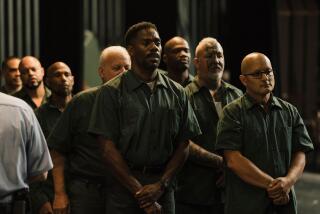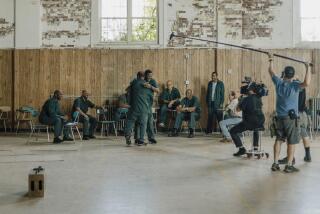Movie Reviews : MORAL ISSUES AND MURDER : âMatewanâ Is More American Folk Epic Than Social Realism
The tradition John Sayles is working from in his flawed but often inspiring âMatewanâ (selected theaters) is that of the Depression-era celebration of the common man, the passionate Upton Sinclair-like outcry against injustice. But itâs less a piece of social realism than an American folk epic, a Western-in-reverse.
It suggests the kind of movies John Ford used to make, with their noble outlaws and community-as-hero. Retelling the history of the West Virginia mining wars of the 1920s through a modern prism, Sayles performs something near an act of faith.
The movie presents a partly factual re-creation of the Mingo County wars of the early â20s--centering on a famous shootout in the Matewan streets. Sayles casts his story in the form of a reminiscence, recalling the dissolution of hostilities between the hill country miners and the blacks and Italian immigrants imported as strikebreakers--as well as the companyâs persecutions and the climactic burst of violence which, in Saylesâ eyes, dooms them all.
The movie doesnât work in purely naturalistic terms, nor does it have the poetic effect of the â40s De Sica-Zavattini films. The three films it suggests most consistently are âThe Grapes of Wrath,â âSalt of the Earthâ and the 1963 Italian film âThe Organizerâ; the last shot of âMatewanâ--consciously or not--almost directly echoes âThe Organizerâsâ final shot. Sayles uses this tradition and the left-wing Depression literary strains as if theyâd never fallen out of fashion. He tells his story straight, hard and simple, like a folk ballad--with a quasi-biblical slant that recalls Steinbeck and fiery, agitating dialogue that suggests Clifford Odets.
Somehow, that simplicity works for him. Telling a story thatâs a celebration of moral bravery in the face of hopeless odds, he turns the film into an act of moral bravery too. The actors and technicians in this low-budget $4-million film--some, like Haskell Wexler or James Earl Jones, probably working for fractions of their usual fee--perform with a dedication that transforms the material, gives it resonance and shine.
Everything is reduced to elements. Overly stylized âfolk wisdomâ pours from some of the charactersâ mouths. The villains--including two great sneering gun thugs, Hickey and Griggs, played by Kevin Tighe and Gordon Clapp--have souls blacker than the coal. And the hero, Chris Cooperâs Joe Kenehan, is a near-saintly pacifist: an ex-Wobblie who preaches unionism as a religion, unites the warring racial factions and constantly counsels against violence--especially to the boy, Danny (Will Oldham) who is our symbolic witness.
Since Kenehanâs opposite number, company spy C. E. Lively (Bob Gunton), constantly urges violence, Saylesâ point is clear. The shootout, which would be a glorious climax in most other modern movies, is a tragic mistake. This dilemma is incarnated in a character who would ordinarily be the movieâs hero: Police Chief Sid Hatfield (David Strathairn), the two-gun stalwart who coolly faces down the mine companyâs detectives. In Strathairnâs subtly menacing performance, Sidâs kindness and bravery become twisted and hasten the doom. Itâs an irony that, while Lively and Hatfield are based on real-life characters--Sid a relative of the legendary feuding Hatfields--noble Joe Kenehan is a complete fiction.
When Saylesâ movies go wrong, itâs often because heâs schematized the conflicts too obviously, let the seams of his argument show. In âMatewan,â some of the midsection climaxes seem too preordained and Kenehan too obviously an exemplar: too removed, at the end, from the action. In a way, Sayles is a natural genre or pattern film maker, who forces himself to be a realist. Here, the four-part narrative structure is so tight that sometimes you feel trapped in it.
But, in âMatewan,â Sayles has pushed himself so hard that he and his company triumph over the mechanical shortcomings. The film, thanks to production designer Nora Chavoosian, has a wonderful period look, plus unerring cinematography by Wexler and acting with a rare ensemble vibrancy. Josh Mostel, Oldham (despite a preppy haircut), Mary McDonnell, Jo Henderson, Nancy Mette and the others listed above are all excellent. But perhaps James Earl Jones, as the gigantic black miner Few Clothes symbolizes the movieâs spirit. Where the others fill their roles almost perfectly, Jones tends to rise above his, infuse it with mythic power and authority.
It may seem that Sayles is trying to revive that simpler, more idealistic view of labor unions that existed in the â30s. But, more than that, perhaps, heâs trying to reintroduce poor people, people who suffer unjustly, as proper subjects for American film making, to bring back a sense of social compassion and conscience. âMatewanâ (MPAA-rated: PG-13) is not so much a celebration of the labor movement as an attempt to reinvoke the idealism that once infused it--and, by extension, make that idealism valid again. When this movie stumbles, it stumbles honestly and sympathetically, but, when it succeeds, it makes history sing. âMATEWANâ
A Cinecom Entertainment Group/Film Gallery presentation of a Red Dog Films production. Producers Peggy Rajski, Maggie Rienzi. Writer/Director John Sayles. Camera Haskell Wexler. Production design Nora Chavoosian. Editor Sonya Polonsky. Music Mason Daring. With Chris Cooper, Will Oldham, James Earl Jones, Mary McDonnell, Kevin Tighe.
Running time: 2 hours, 12 minutes.
MPAA rating: PG-13 (parents are strongly cautioned; some material may be inappropriate for children younger than 13).
More to Read
Only good movies
Get the Indie Focus newsletter, Mark Olsen's weekly guide to the world of cinema.
You may occasionally receive promotional content from the Los Angeles Times.







